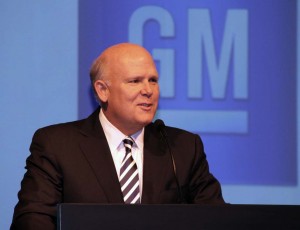After an agonizingly slow start Chevrolet’s plug-in hybrid, the Volt, is finally showing signs of powering up – October sales jumping 50% over the previous month, though the battery car appears all but certain to miss its ambitious target for 2011.
Despite that shortfall – and the fact that is lagging well behind its primary competitor, the Nissan Leaf battery-electric vehicle, General Motors CEO Dan Akerson contends he is pleased with the progress of the Chevy Volt and insists it is on target for its even more ambitious 2012 sales goal.
The U.S. giant plans to produce 60,000 Chevrolet Volts next year, with 15,000 of them planned for export and the rest aimed at the U.S. market.
“Everything we’ve seen is this thing has been a home run,” Akerson said during an appearance on the cable network CNBC today, the former telecomm exec adding that GM is already “ramping up production” even though it will struggle to meet its 2011 sales target.
“Now we’re starting to hit the pace,” said Akerson.
Chevy sold 1,108 Volts last month, the first time it came close to that figure – and it notably outsold the Leaf during October, sales of the Nissan battery car slipping to just 849. But for the year to date, the Nissan Leaf still leads, 8,048 units to just 5,003 for Volt.
Barring another massive jump in sales there appears to be little opportunity for Volt to hit its 10,000 target for all of 2011. But analysts now believe that despite initial skepticism Volt is finally plugging into the market. The question is whether Chevy can more than triple demand yet again in the months ahead.
To meet its 2012 target Chevy would have to sell an average 3,750 Volts monthly – nearly as many as it managed to move during the first nine months of 2011.
But for most of the current year the plug-in was being offered only in a handful of so-called “launch markets,” including California, Washington, DC, and Michigan. Volt is now available through Chevrolet dealers across the U.S. The maker also began sharply ramping up production, as Akerson noted, following a summer break at an assembly plant in the City of Detroit.
As for Leaf, October brought an unexpected slide in sales after Nissan saw demand steadily grow over the summer. Sales peaked at 1,342 in August before dipping to 1,031 in September and unless the maker can boost demand from October’s anemic 849 it might also fall short of its 2011 sales target of 10,000 to 12,000 of the battery-electric vehicles.
Nissan’s 2012 target also anticipates some big growth, at 20,000 units, but nowhere near the boom that GM is forecasting for Volt. The Japanese maker remains one of the industry’s big proponents of electric propulsion, and is preparing to begin production of the Leaf in Smyrna, Tennessee in 2012. By mid-decade, Nissan and its French alliance partner Renault expect to have the worldwide capacity to produce 450,000 battery cars annually.

